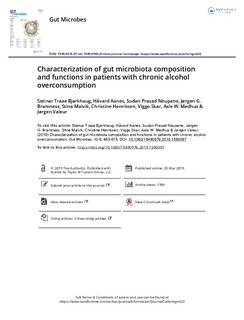| dc.contributor.author | Bjørkhaug, Steinar Traae | |
| dc.contributor.author | Aanes, Håvard | |
| dc.contributor.author | Neupane, Sudan Prasad | |
| dc.contributor.author | Bramness, Jørgen Gustav | |
| dc.contributor.author | Malvik, Stine | |
| dc.contributor.author | Henriksen, Christine | |
| dc.contributor.author | Skar, Viggo Øystein | |
| dc.contributor.author | Medhus, Asle Wilhelm | |
| dc.contributor.author | Valeur, Jørgen | |
| dc.date.accessioned | 2019-12-13T07:33:15Z | |
| dc.date.available | 2019-12-13T07:33:15Z | |
| dc.date.created | 2019-03-21T16:36:03Z | |
| dc.date.issued | 2019 | |
| dc.identifier.citation | Gut microbes. 2019, 10 (6), 663-675. | nb_NO |
| dc.identifier.issn | 1949-0976 | |
| dc.identifier.uri | http://hdl.handle.net/11250/2633051 | |
| dc.description.abstract | Excessive alcohol intake can alter the gut microbiota, which may underlie the pathophysiology of alcohol-related diseases. We examined gut microbiota composition and functions in patients with alcohol overconsumption for >10 years, compared to a control group of patients with a history of no or low alcohol intake. Faecal microbiota composition was assessed by 16S rRNA sequencing. Gut microbiota functions were evaluated by quantification of short-chain fatty acids (SCFAs) and predictive metagenome profiling (PICRUSt). Twenty-four patients, mean age 64.8 years (19 males), with alcohol overconsumption, and 18 control patients, mean age 58.2 years (14 males) were included. The two groups were comparable regarding basic clinical variables. Nutritional assessment revealed lower total score on the screening tool Mini Nutritional Assessment, lower muscle mass as assessed by handgrip strength, and lower plasma vitamin C levels in the alcohol overconsumption group. Bacteria from phylum Proteobacteria were found in higher relative abundance, while bacteria from genus Faecalibacterium were found in lower relative abundance in the group of alcohol overconsumers. The group also had higher levels of the genera Sutterella, Holdemania and Clostridium, and lower concentration and percentage of butyric acid. When applying PICRUSt to predict the metagenomic composition, we found that genes related to invasion of epithelial cells were more common in the group of alcohol overconsumers. We conclude that gut microbiota composition and functions in patients with alcohol overconsumption differ from patients with low consumption of alcohol, and seem to be skewed into a putative pro-inflammatory direction. | nb_NO |
| dc.language.iso | eng | nb_NO |
| dc.publisher | Taylor & Francis | nb_NO |
| dc.rights | Attribution-NonCommercial-NoDerivatives 4.0 Internasjonal | * |
| dc.rights.uri | http://creativecommons.org/licenses/by-nc-nd/4.0/deed.no | * |
| dc.title | Characterization of gut microbiota composition and functions in patients with chronic alcohol overconsumption | nb_NO |
| dc.type | Journal article | nb_NO |
| dc.type | Peer reviewed | nb_NO |
| dc.description.version | publishedVersion | nb_NO |
| dc.source.pagenumber | 663-675 | nb_NO |
| dc.source.volume | 10 | nb_NO |
| dc.source.journal | Gut microbes | nb_NO |
| dc.source.issue | 6 | nb_NO |
| dc.identifier.doi | 10.1080/19490976.2019.1580097 | |
| dc.identifier.cristin | 1686820 | |
| dc.description.localcode | © 2019 The Author(s). Published with license by Taylor & Francis Group, LLC. This is an Open Access article distributed under the terms of the Creative Commons Attribution-NonCommercial-NoDerivatives License (http://creativecommons.org/licenses/by-nc-nd/4.0/), which permits non-commercial re-use, distribution, and reproduction in any medium, provided the original work is properly cited, and is not altered, transformed, or built upon in any way. | nb_NO |
| cristin.unitcode | 194,65,0,0 | |
| cristin.unitname | Fakultet for medisin og helsevitenskap | |
| cristin.ispublished | true | |
| cristin.fulltext | original | |
| cristin.qualitycode | 1 | |

